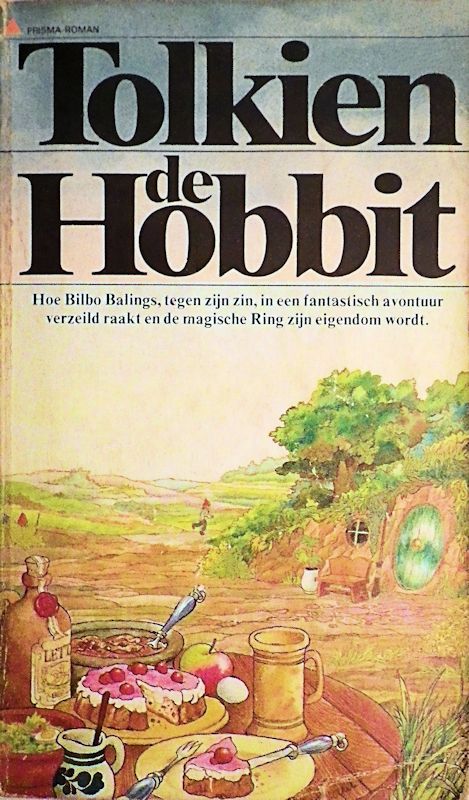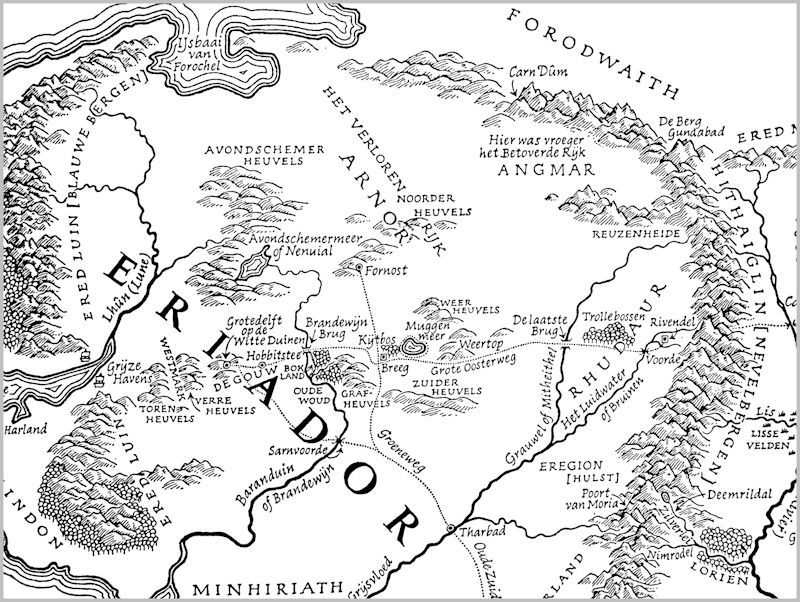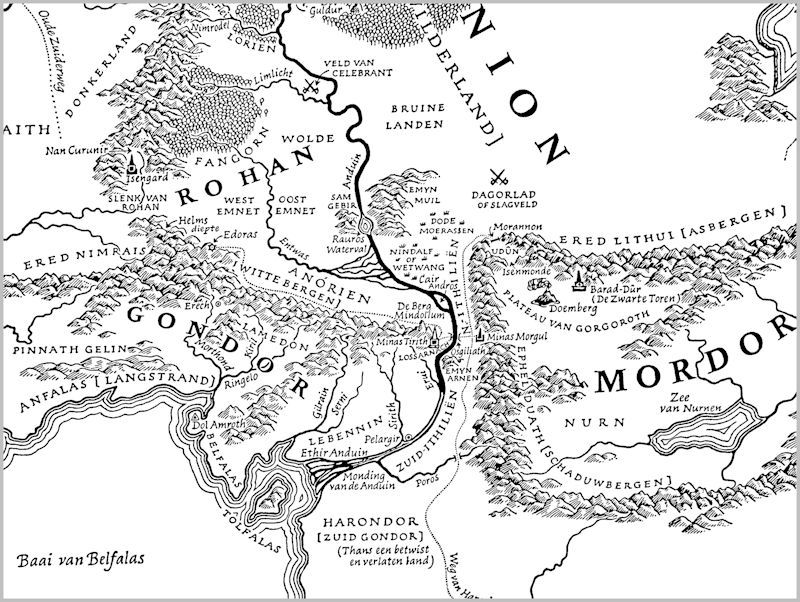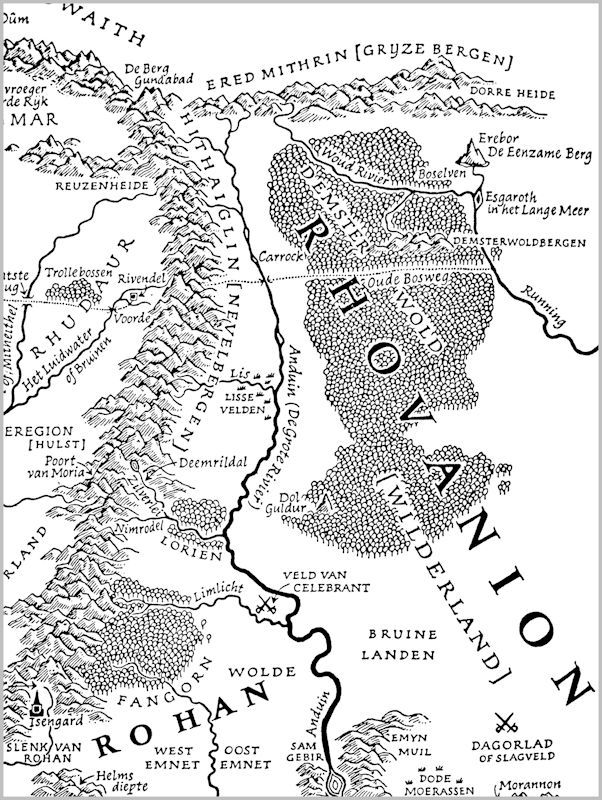Middle Earth in Dutch
The first time I read The Lord of the Rings and The Hobbit was in the Dutch translation by Max Schuchart. I still have the books.


© Het Spectrum 1956 © Het Spectrum 1960
The cover of "In de ban van de ring" shows Frodo, doing his disappearing act at Bree. The image above has always puzzled me. Is it Merry or Pippin being carried off to Isengard with Gimli and Legolas in pursuit? Or is it Frodo followed by Sam (carrying Sting) with his "great elf warrior"-persona hovering above him?
The illustration on the cover of De Hobbit is more straight-forward. It shows Bilbo running off after the dwarves, leaving a very hobbity meal behind. The subtitle reads (in translation): "How Bilbo Baggins, against his will, gets involved in a fabulous adventure and acquires the magic Ring".
More interesting than the covers are the maps inside the books. One reason why Middle Earth seems so real is that Tolkien invented such evocative names for his countries, mountains, rivers, lakes, forests and dwelling places. So, translators all over the world must have struggled to get it right.
The Dutch translation was the first one to appear and, unfortunately, Tolkien had some very strong objections to it. He wrote:
"In principle I object as strongly as is possible to the "translation" of the nomenclature at all (even by a competent person). I wonder why a translator should think himself called on or entitled to do any such thing. That this is an "imaginary" world does not give him any right to remodel it according to his fancy, even if he could in a few months create a new coherent structure which it took me years to work out. [...] May I say at once that I will not tolerate any similar tinkering with the personal nomenclature. Nor with the name/word Hobbit (3 July 1956, to Rayner Unwin, Letters, pp. 249-51)"
In spite of Tolkien's injunction, "similar tinkering" occurred in all other translations. (translated names).
So, what does a native Dutch speaker (me) think about Max Schuchart's translation of the names of characters and places?
I largely agree with this comment (from wikipedia: Translations of The Lord of the Rings):
"However, if one reads the Dutch version, little has changed except the names of certain characters. This to ensure that no reading difficulties emerge for Dutchmen who don't speak English"
With regard to the names of characters: Balings, Stapper, Brandebok, Toek, Gewissies, Boterbast and Boombaard convey the essence of the characters much better to a non-English speaking Dutchman than their English originals would have done. The same is true for many of the place names.
I love maps, so I've added some to this post with my comments on translation.
The Shire
What I like about this map is that they printed the names of the four farthings the right way up instead of tilted/upside down as in the English version.
Most place names have been translated in this map, which makes sense because they were in English, rather than one of the Elvish languages. In general, the translations work very well for me. They have the same rural flavor in Dutch as they have in English.
Many names are just literal translations from the English original ("Overheuvel", "Tookburg", "Wegemoet", "Distelbeek", "Stokbeek", "Brandewijn", "Wilgewinde", "Naaldhol" and others).
There are some really inspired choices, such as "Grotedelft" for Michel Delving, "Brockenschacht" for Brockenborings, "Ringel-eiland" for Girdley Island, "Dieprading" for Deephollow, "Bosrode" for Woodhall and "Geenhuyzen" (= "no houses" in archaic Dutch) for Nobottle.
Some translations needed a bit of research before I understood the translator's thought process. At first, I couldn't see why Frogmorton had to become "Puitenlee" until I found out that "puit" is an archaic Dutch word for frog.
But I still don't understand why Pincup became "Vinkop" (not that the English name Pincup created any visual image in my mind, either).

© Het Spectrum 1956
The other maps in this post are cut-outs from a large map of the whole of Middle Earth that occurs as a 30x30 cm fold-out sheet at the inside of the front of my book. In this map, the translator has deviated less from Tolkien's original than in the Shire map.
Eriador
Translating Harlond into "Harland" seems wrong to me. Harlond is not of English origin but a Sindarin word for Southhaven (tolkiengateway). The quays and docks for river traffic from the south to Minas Tirith have the same name. This is not a typo because Forlond (just outside my cut of the map) was also translated into "Forland".
I'm puzzled by the translation of Chetwood (near Bree) into "Kijtbos". In the text, Kijtbos is used only once; later on it is referred to as "Boogbos". According to tolkiengateway, the element chet (also found in Archet) is of Celtic origin and means "wood". So, "Boogbos" (English translation = Bow-wood) isn't quite right either.
I loved the translation of Hoarwell into "Grauwel". It's a perfect name for a river having its source in the gray, cold north of the Misty Mountains.

© Het Spectrum 1956
Gondor, Rohan, Mordor
This map contains a very funny error. The rapids of Sarn Gebir are given as "SAM GEBIR". The translator must have had dear Sam uppermost in his mind. But the error is understandable; it is easy to misread sarn for sam in small print.
All other names are either untranslated or straight-from-the-dictionary translations of English words.

© Het Spectrum 1956
Rhovanion
Again, most names are either untranslated or standard translations of English words.
I love the choice of "Demsterwold" for Mirkwood. "Demster" is not an existing Dutch word but we have "deemster", meaning darkness or gloom.

© Het Spectrum 1956


© Het Spectrum 1956 © Het Spectrum 1960
The cover of "In de ban van de ring" shows Frodo, doing his disappearing act at Bree. The image above has always puzzled me. Is it Merry or Pippin being carried off to Isengard with Gimli and Legolas in pursuit? Or is it Frodo followed by Sam (carrying Sting) with his "great elf warrior"-persona hovering above him?
The illustration on the cover of De Hobbit is more straight-forward. It shows Bilbo running off after the dwarves, leaving a very hobbity meal behind. The subtitle reads (in translation): "How Bilbo Baggins, against his will, gets involved in a fabulous adventure and acquires the magic Ring".
More interesting than the covers are the maps inside the books. One reason why Middle Earth seems so real is that Tolkien invented such evocative names for his countries, mountains, rivers, lakes, forests and dwelling places. So, translators all over the world must have struggled to get it right.
The Dutch translation was the first one to appear and, unfortunately, Tolkien had some very strong objections to it. He wrote:
"In principle I object as strongly as is possible to the "translation" of the nomenclature at all (even by a competent person). I wonder why a translator should think himself called on or entitled to do any such thing. That this is an "imaginary" world does not give him any right to remodel it according to his fancy, even if he could in a few months create a new coherent structure which it took me years to work out. [...] May I say at once that I will not tolerate any similar tinkering with the personal nomenclature. Nor with the name/word Hobbit (3 July 1956, to Rayner Unwin, Letters, pp. 249-51)"
In spite of Tolkien's injunction, "similar tinkering" occurred in all other translations. (translated names).
So, what does a native Dutch speaker (me) think about Max Schuchart's translation of the names of characters and places?
I largely agree with this comment (from wikipedia: Translations of The Lord of the Rings):
"However, if one reads the Dutch version, little has changed except the names of certain characters. This to ensure that no reading difficulties emerge for Dutchmen who don't speak English"
With regard to the names of characters: Balings, Stapper, Brandebok, Toek, Gewissies, Boterbast and Boombaard convey the essence of the characters much better to a non-English speaking Dutchman than their English originals would have done. The same is true for many of the place names.
I love maps, so I've added some to this post with my comments on translation.
The Shire
What I like about this map is that they printed the names of the four farthings the right way up instead of tilted/upside down as in the English version.
Most place names have been translated in this map, which makes sense because they were in English, rather than one of the Elvish languages. In general, the translations work very well for me. They have the same rural flavor in Dutch as they have in English.
Many names are just literal translations from the English original ("Overheuvel", "Tookburg", "Wegemoet", "Distelbeek", "Stokbeek", "Brandewijn", "Wilgewinde", "Naaldhol" and others).
There are some really inspired choices, such as "Grotedelft" for Michel Delving, "Brockenschacht" for Brockenborings, "Ringel-eiland" for Girdley Island, "Dieprading" for Deephollow, "Bosrode" for Woodhall and "Geenhuyzen" (= "no houses" in archaic Dutch) for Nobottle.
Some translations needed a bit of research before I understood the translator's thought process. At first, I couldn't see why Frogmorton had to become "Puitenlee" until I found out that "puit" is an archaic Dutch word for frog.
But I still don't understand why Pincup became "Vinkop" (not that the English name Pincup created any visual image in my mind, either).

© Het Spectrum 1956
The other maps in this post are cut-outs from a large map of the whole of Middle Earth that occurs as a 30x30 cm fold-out sheet at the inside of the front of my book. In this map, the translator has deviated less from Tolkien's original than in the Shire map.
Eriador
Translating Harlond into "Harland" seems wrong to me. Harlond is not of English origin but a Sindarin word for Southhaven (tolkiengateway). The quays and docks for river traffic from the south to Minas Tirith have the same name. This is not a typo because Forlond (just outside my cut of the map) was also translated into "Forland".
I'm puzzled by the translation of Chetwood (near Bree) into "Kijtbos". In the text, Kijtbos is used only once; later on it is referred to as "Boogbos". According to tolkiengateway, the element chet (also found in Archet) is of Celtic origin and means "wood". So, "Boogbos" (English translation = Bow-wood) isn't quite right either.
I loved the translation of Hoarwell into "Grauwel". It's a perfect name for a river having its source in the gray, cold north of the Misty Mountains.

© Het Spectrum 1956
Gondor, Rohan, Mordor
This map contains a very funny error. The rapids of Sarn Gebir are given as "SAM GEBIR". The translator must have had dear Sam uppermost in his mind. But the error is understandable; it is easy to misread sarn for sam in small print.
All other names are either untranslated or straight-from-the-dictionary translations of English words.

© Het Spectrum 1956
Rhovanion
Again, most names are either untranslated or standard translations of English words.
I love the choice of "Demsterwold" for Mirkwood. "Demster" is not an existing Dutch word but we have "deemster", meaning darkness or gloom.

© Het Spectrum 1956